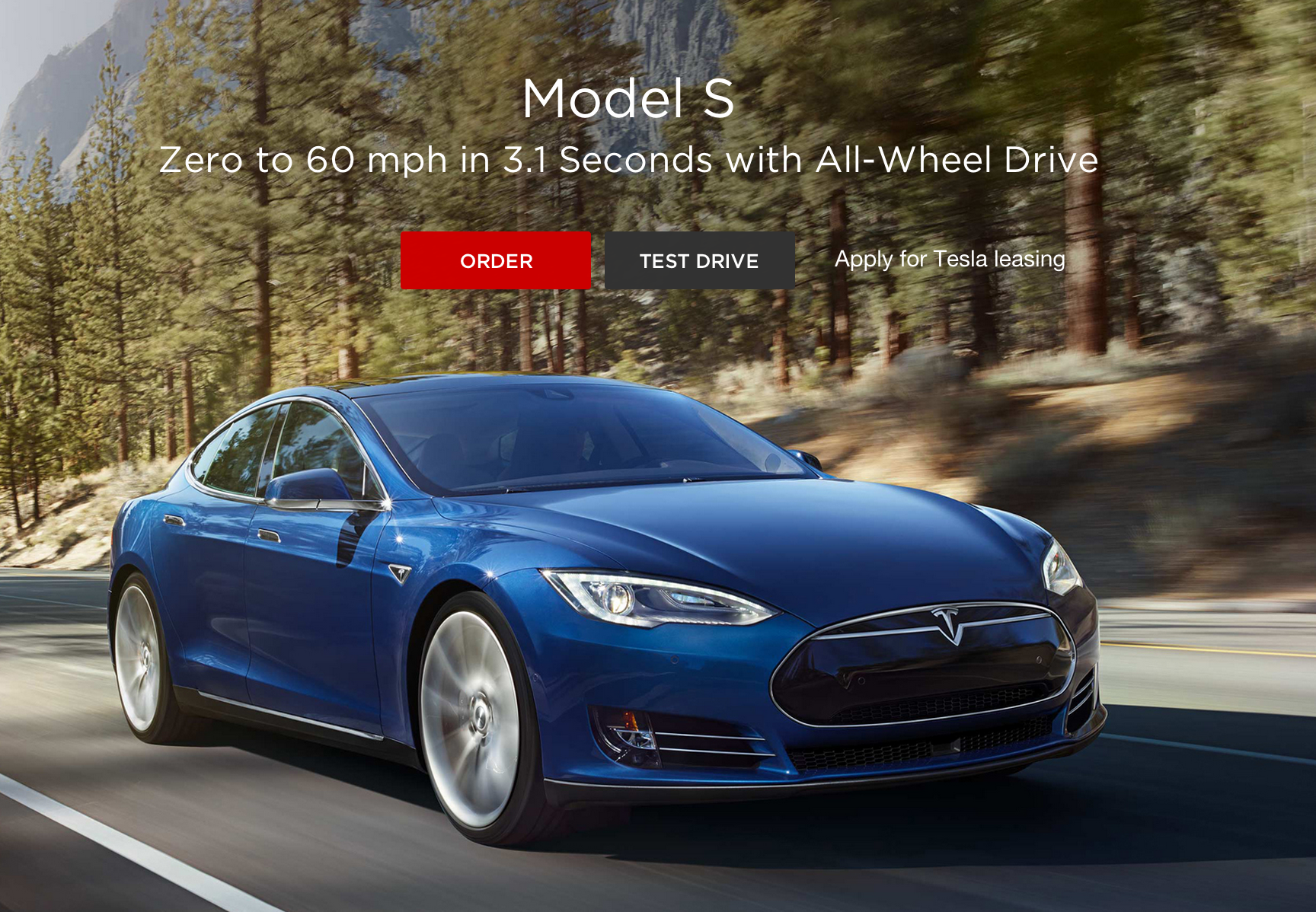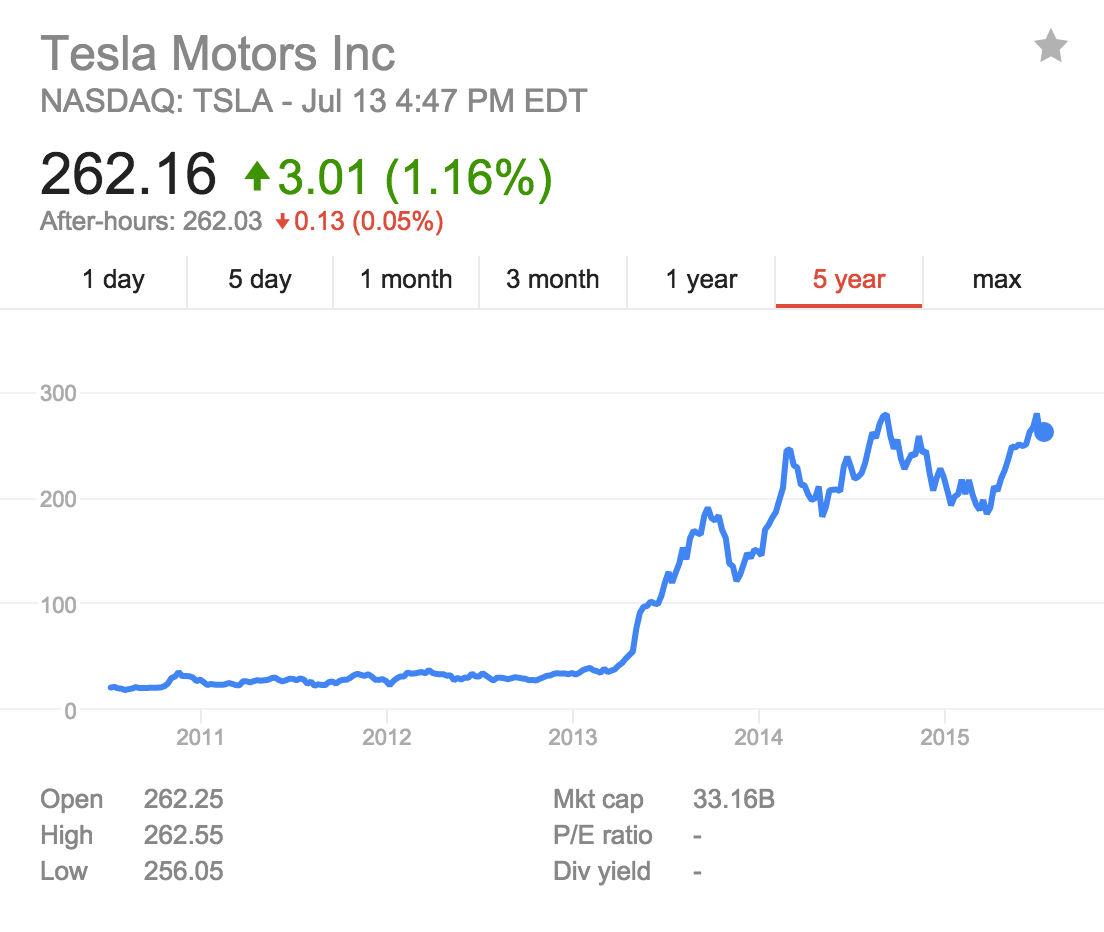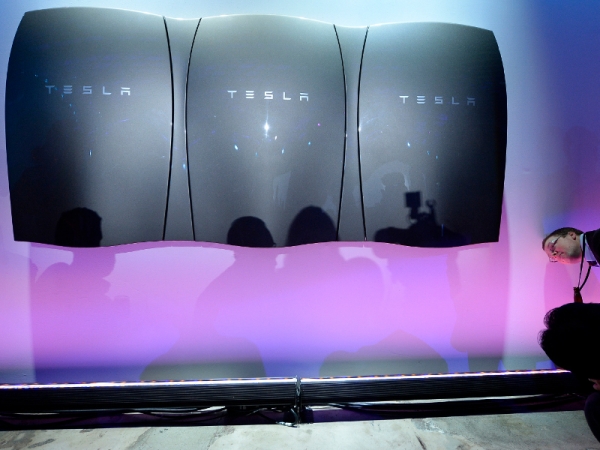An article I read this morning from Matthew DeBord about Tesla reignited some cylinders (pun intended…wait, electric motors don’t have cylinders) of thought.
In his article, DeBord (like may of us) tries to reconcile the ebbs and flows of Tesla’s stock. I totally agree that the company’s promise of future value has driven the price, and kept it close to, its all-time high of $291. Deutsche Bank’s Rod Lache agrees, noting Tesla’s value prospects are already reflected in the stock price…So if you buy now, you’re not going to be purchasing that growth. It’s too late.


Tesla’s story is one that’s difficult to not fall in love with. Its vision of the future is enchanting. Per Elon Musk, Tesla’s mission is to accelerate the advent of sustainable transport by bringing compelling mass market electric cars to market as soon as possible. The fact that the performance of said cars rivals that of the most expensive supercars in the world? Icing on the cake.
So, is it in fact too late?
No, Lache, it’s not.
A word on strategy and vision
Musk has told us that “the strategy of Tesla is to enter at the high end of the market, where customers are prepared to pay a premium, and then drive down market as fast as possible to higher unit volume and lower prices with each successive model.” The original Tesla Roadster was the first step. The Model S was the second. The third will include the Model 3 or the SUV. And so on and so on. But what everyone forgets is that cars are not the value behind Tesla as a company or stock. They are what’s fueling (pun intended, because they don’t use fuel. Pun within a pun? Inception pun?) Tesla’s true purpose.
Tesla was not founded to just build another expensive sports car. Tesla was founded with the vision and ultimate goal of turning the world ‘energy positive.’ The purpose of Tesla as a company is to help expedite the move from a mine-and-burn hydrocarbon economy towards a ‘new world’ solar electric economy. I’m talking a full-on switch. A new world order. This takes a lot. The infrastructure needs to be created. Solar fields need to replace oil fields. Consumer habits need to change. Tesla needs to pry consumers’ hands free from the steering wheels of the inefficient and dirty petrol cars we’ve come to love. Tesla needs to become as common as Uber. (Tesla & Uber are already talking about this).
So, how has Musk going to accomplish this? The strategy is more simple than you may think. He’s flat out told us.
A strategy so good that you could finally get Russia when playing the board game Risk
- Build a (electric) sports car that everyone wants (Roadster)
- Use that money to build an affordable car (Model S)
- Use that money to build an even more affordable car (Model 3)
- While doing the above, also provide (via owned or partnered solutions) zero-emission electric power offerings to build out the infrastructure to support the cars and a new standard of energy (Supercharger network, Powerwall, offering a modestly sized and priced solar panel from SolarCity, etc.)
Musk has told us this many times. We ignore it because unlike him, we don’t have the foresight to see through a stock ticker going up and down.
Let’s think about this.
Most of us start companies as a means to an end. Make a living, build and sell, then retire on the beach. Usually the vision (and thinking) ends there. Musk started a company to facilitate him changing the world. Literally. To make it so easy and desirable for everyone to dump fossil fuels that they have no excuses left to not go electric.
And the four-step strategy above? In a word, genius.
DeBord asserts that Tesla is a car company, nothing more and just needs to start cranking out cars. Yes, we need the cars, but the cars are a small piece of the puzzle.
What’s your company’s vision? At Infusionsoft, our mission is to help small businesses succeed. Our software is just the beginning. I’m limited in what I can disclose; however, we are exploring other areas and infrastructure that small businesses need to succeed. Affordable credit card processing and launching Infusionsoft Payments last month is an example of this thinking.
Don't be fooled by short-term, lagging or reactionary metrics. Otherwise, you miss the big picture.
Changing consumer behavior is hard.
We marketers know this is harder than just about anything. Regardless, we’re pretty good at it because we have all these psychological tricks up our sleeves. Want to raise your average SaaS MRR? Arrange your pricing packages on the page from highest to lowest, not the other way around. Need to sell a $1,000 product? Reframe the value. $84/mo is the same thing as $1,000 and is far more palatable. Want to tack on a whole bunch of ancillary products? Bundle them into packages instead of line items.
But how on earth do you get people go against everything they’ve ever known and switch to an electric car?
…
Helper #1: Playing to hedonism and consumerism
Well, thankfully for Musk, physics is helping him out here. Ferrari performance for non-Ferrari cost is a pretty difficult thing to say “no” to.
BMW was the first automaker to focus on the emotions their cars created in drivers, not the cars themselves. As I discuss in my thesis, the JOY campaign was wildly successful for BMW and pivotal for auto marketing as a whole. As we say in product marketing, DON’T TALK ABOUT THE PRODUCT! The way it makes people feel is more important that what it actually is.
Helper #2: Having a vision greater than oneself
Aside from this, let’s circle back on Tesla’s vision and purpose. Laying the infrastructure and tackling one of the biggest points of petrol consumption (transportation) to turn the world energy-positive. That is astounding. Just think, all those hippy ads that Honda ran may actually become reality.
But it really works.
Take a look at Infusionsoft. Our mission is to help small businesses succeed. Not to swim upstream to where the money is in CRM and marketing automation. Our CEO has explicitly said that we do not care about big business. We know there’s a ton of money in it. But we don’t care.
When your vision does, in fact, become the essence of your brand, it’s something customers can relate to. It resonates. You can’t fake that.
Helper #3: Grease the rails and make it stupid easy for consumers to consume
This is something that’s a huge challenge in SaaS. Software, by nature, is incredibly complex. You know what else is complex? Buying a car. You know what’s more complex than buying a car? Buying an electric car. Or is it?
Customer journey buying a normal car
“Oh boy! I can’t wait to go to the dealership and tell them I’m interested in a new car!” said no one ever.
Great, you’re looking for a new car. You hop on the manufacturer website and are forced through one of 3 options: “search inventory,” “dealer locator” or “get a quote.” Those damned marketers and their damned funnels. Before you are able to even navigate to your local dealer’s website to search inventory, the emails begin. An hour or so later, so do the phone calls. “I love these” said no one ever. Do they tell me what I want to know about the car or give me the information I’m looking for? No. They’re relentless, rabid sales pitches. Clearly inbound marketing hasn’t been adopted by car dealers yet.
I cave and talk to someone from the dealer. They pump me full of enough artificial courage to timidly drive into the dealer lot, where I’m treated as fresh meat by an army of bro sales guys. “Oh, you want this model? But we have this one that’s so much better!” And so it begins. The sales tactics. No, I don’t care about your family picture on your desk, stop turning it towards me. No, I won’t sign your silly “we have a deal” paper contract you drew with a pencil. No, I know that every time you ‘have to go ask’ your sales manager, you are actually getting a coffee or checking Facebook. For the love of god, please stop forcing me through your archaic sales funnel using tactics my kid has already figured out. I’m not enjoying it (or falling for it).
Finally, after an arduous experience, I drive off the lot with a new car.
Then they call me to tell me they calculated my financing wrong and the interest rate is actually higher than agreed.
Then the car brakes and I have to take it in for maintenance, where I’m gouged again. And again. And again. And again. With each oil change, there’s always something else wrong.
Then I go to trade the car in, and the process starts all over again.
Customer journey buying a Tesla
I go to Tesla’s website.
Regardless of what I want to do, it’s at my fingertips. “Order,” “test drive,” “apply for Tesla leasing,” are dominant CTAs. If I click into the model subpages, I am educated on the car. But unlike other manufacturers, Tesla has proactively answered all my burning questions and is incredibly transparent about numbers.
“How far does each one go on battery?” Here’s a chart.
“What’s my range per charge based on the outside temperature, speed at which I’m driving and other factors?” Here’s a calculator.
“What if I want to drive from Phoenix to San Diego?” You get free charting at our Supercharger stations.
….”What if I think of any question that you haven’t already answered?” We authored a help center that neatly categorizes topics, just like a tech company.
Viola. Inbound versus sales funnel.
Sweet, let’s price this baby out!
Oh.
My.
God.
It feels like any other ecomm website I’ve grown accustomed to as a consumer. This is so easy! Add, take away, re-add…dynamic pricing…toggle between ‘order’ and ‘lease,’ price and details adjust…and all I have to do is click ‘order’ and it’s done? This is too easy.
Oh wait, I need one of those wall charger thingies. Wow, they help me find a qualified electrician near me? And they even geo-located my IP address so I don’t have to fill out annoying forms? Bravo.
Ok, these guys are good. What about maintenance? Electric cars don’t need oil changes but they must need something. Wow, they offer prepaid service plans? Or they’ll come to me?
I…must have this now. Click. Done.
Night and day. If I wanted a customized car, I’d have to battle the manufacturer’s online builder, print the spec sheet, take it into a dealer and suffer through the typical dealer experience while they ordered the car. Ordering a customized Tesla? As easy as ordering shampoo off Amazon.
Ask yourself:
- Does your company have a solid vision that’s more than self-serving?
- Do you have a concrete strategy to make that vision a reality? (More than the aimless fluff that comes out of quarterly planning meetings?)
- Do you make it this easy for your customers to…
- Get answers to their pre-purchase questions?
- Buy from you?
- Get help post-purchase?
- Why you haven’t bought a Tesla already (hurry, the incentives are capped!)

Justin Topliff
Director of Product Marketing, VTS
Justin is Director of Product Marketing at VTS and the founder of the Product Marketing Summit. He is an authority on product marketing and enjoys fostering the genesis and expansion of the product marketing function at growth stage companies and developing product marketing talent. He lives in New York though he’ll probably be in your geo soon.

